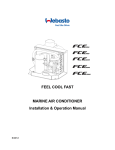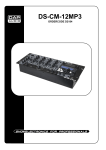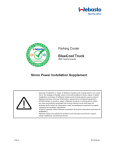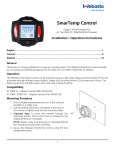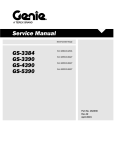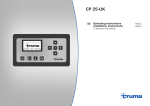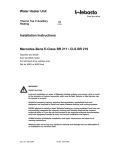Download Diesel Cooker x100 Service Manual
Transcript
Diesel Cooker x100 Service Manual 08-05-2008 Webasto Diesel Cooker X 100 Table of Contents 1. General 1.1 Contents and purpose 1.2 Use of the cooker 1.3 Additional documentation 1.4 Safety notes and legal issues 1.5 Suggestions for improvements and changes 101 101 101 101 101 2. Function description 2.1 System description 2.2 Main components 2.3 Operating scheme 3. Technical Data 201 202 207 301 4. Failure detection 4.1 Trouble shooting chart 4.2 General failures 4.3 Failure blink codes 402 403 406 5. Updating and repair 5.1 Updating 5.2 Test program 5.3 Burner 5.4 Glow plug 5.5 Heat exchanger and glass panel 5.6 Pump Boost 6. Electrical connections 501 503 504 506 507 508 601 7. Maintenance and service 7.1 Basic maintenance 7.2 Control unit settings 701 703 Webasto Diesel Cooker X 100 1 General 1 General 1.5 Suggestions for improvements and changes 1.1 Contents and purpose Complaints, improvement suggestions or corrections relating to this workshop manual should be addressed to: This workshop manual is designed to assist trained personnel with repairing the Webasto Diesel Cooker X 100. Webasto Product North America, Inc. Technical Documentation Group 15083 North Road Fenton MI 48430 Phone: (800) 555-4518 Fax: (810) 593-6001 1.2 Use of the cooker The Webasto Diesel Cooker is designed for use in motorcaravans. It is not designed for use in boats. 1.3 Additional documentation This workshop manual contains all the information and instructions required for repairing the Webasto Diesel Cooker X 100. If necessary the operating / installation instructions may also be used. You are also invited to fill out our online questionnaire concerning our technical documentation and web site at: www.techwebasto.com 1.4 Safety notes and legal issues In principle, the general accident prevention regulations and current works safety instructions are applicable. Webasto Diesel Cooker X100 is tested by SGS, test spesification standard EN 1:1998 + EN 60335-26:2003 Failure to follow the installation instructions and the notes contained therein will lead to all liability being refused by Webasto The same applies if repairs are carried out incorrectly or with the use of parts other than genuine spare parts. You must read the operating manual before starting the heater for the first time. 101 Webasto Diesel Cooker X 100 2 Functions description 2 Functions description 2.1 System description The Webasto Diesel Cooker X 100 is a safe diesel cooker with no open flame. The exhaust gases are led out of the vehicle through the exhaust gas tube, which is inside the cooling air tube. The steam from the exhaust gas will not stay in the vehicle to add humidity. As the diesel fuel burns, the released heat is transferred to the ceramic plate. The hottest area is on the round plate. Gentler heat is available on the oblong extension. The heating power is adjustable. a Main cooking area A cooling fan in the ventilation box ensures that the temperature in the mounting space will not rise too high. The warm air is led out through the cooling air tube. The cooker is ideally suited for cooking and heating of all kinds of food. The cooker is made entirely of stainless materials. Hot plate indication lamp Additional cooking area Mounting piece Exhaust gas tube Fuel pump Temperature sensor Fuel needle Glow plug Overheat thermostat Combustion air fan Control unit Burner chamber Cable lead-through Ventilation box Cooling fan 201 Fuel hose lead-through Webasto Diesel Cooker X 100 2 Functions description 2.2 Main components Operating panel The cooker starts to heat up automatically when the power button is switched to ON position. The yellow indicator lamp lights up as soon as the cooker is switched on. The red combustion lamp will light up when the combustion is stabilized in the burner, about 2.5-4 minutes after the start-up. Power indication lamp (yellow) Combustion indicator lamp (red) Power switch Power adjustment High altitude indication lamp (orange) High altitude switch Start Power indication lamp 1 Stop ⇓ ⇓ Yellow 0 Combustion Red indication lamp Start-up 2.5-4 min Cooking 1 0 0,25 s 0,25 s 0,25 s 0,25 s Run down phase about 5 min Signal lights of operating panel during normal operation 202 Webasto Diesel Cooker X 100 2 Functions description Fuel pump Combustion air fan The fuel pump is a combined transport, metering and shut-off system for supplying fuel from the vehicle’s tank to the cooker. The voltage range of the burning fan may be altered between 4.8 V and 10.7 V by changing the parameters; the adjustment range of the parameters is 4,000 mV – 11,000 mV. Check the voltage in the last parameter file. During the first second of start-up the control unit tests the fan’s motor. During the following second, the motor receives an initial impulse of 7 V from which the voltage is decreased to the minimum set forth in the parameters. The voltage will be increased linearly towards the maximum during the start-up cycle; the maximum will be reached in approximately 4 minutes and 50 seconds after the start-up cycle ends. The power control does not work during this time. After the start-up cycle, the burning fan adjusts itself from maximum to minimum and minimum to maximum at a rate of 5 % per second (20 sec. max. > min.). The adjustment range for the pump’s pulsing is 0.5 sec. - 4.5 sec.; adjustment is linear. Check the length of the pulsing in the last parameter file. After turning the operating switch to the ON position, the pump will be at a standstill for 30 seconds after which the pump’s pulsing will begin to rise linearly towards the maximum setting; it will reach the maximum 4 minutes and 50 seconds after the start-up cycle ends. The power adjustment will not work during start up cycle. When you adjust the device from maximum to minimum, the pump’s impulse interval will immediately drop, step by step, to the value of the minimum pulse interval (+ 0.5 sec.). After this, the pulse will excellerate until it reaches the normal pulse interval at the minimum output. In other words, if the pulse interval at the maximum is 1 second and at the minimum 3 seconds, then the pulse interval will decrease immediately to 3.5 seconds when adjusting from maximum to minimum. It will rise from that point in 20 seconds to 3 seconds. Heat exchanger The heat generated by the combustion process is transferred to the air transported by the combustion air blowers into the heat exchanger. There it gives off heat to the ceramic glass panel. The exhaust gas then exits through the exhaust gas tube and is ducted outside the vehicle through the stainless steel exhaust tube. Glow plug Heat exchanger During the first second of ignition the glow plug receives quick pulses, with which you can make sure it is working properly. During the 2nd second, voltage increases with a pulse ratio of 25 %. After 5 seconds, the pulse ratio increases to 70 %; and after 15 seconds, the voltage increases to 100 %. Programmed ignition monitoring will begin 15 seconds after start-up, before which there is only mechanical protection. HF V VH H WLR WLR UD UD H WLR UD V V XO OV S X S F VH VH XO S XO S FN XL T HF F VH V The principle of operation of the ignition voltage 203 Webasto Diesel Cooker X 100 2 Functions description Temperature sensors Hot plate indication lamp The T4 circuit measures the voltage of the heat sensor (thermocouple) and will light the red LED light if the voltage exceeds the limit (10 mV). Ten seconds after start-up the T4 will begin recognizing the voltage. The burning detection limit is 10 mV and it will be raised 30 % at the same pace as the voltage rises. The burning detector’s (red LED light) ignition indicator is 10 mV and its shut-down indicator is 13 mV. There is an 8-second delay from the time the burning detector shuts off until the pump shuts down. The lock-up detector will automatically reset from the burning detector. The red LED light will indicate whether or not the burning detector is functioning. See 2.2 “Descriptions of flashing lights”. An orange hot plate indication lamp lights on the lower edge of ceramic plate when the plate is hot. The hot plate indication lamp will light up immediately after the start. The lamp will remain on for 50 minutes (± 10 %) after the cooker has been turned off. Control unit The control unit is the central component for ensuring the cooker’s function and monitoring for proper cooker operation. If a fault occurs, an error code will be output in the LEDs of the operating panel by various flashing sequences. In addition, the heater’s parameters and running hours can be checked using a personal computer. T3 is a overheat thermostat. When the temperature rises over 150° C (302° F) power is removed from the fuel pump and the unit goes into a cooling phase.The thermostat will automatically return to the On position after the unit cools. Note! You must be sure you have ESD protection while handling the control unit. Static electricity can damage the control unit. Control panel Wires for control panel Thermo element Electrical connections for the control unit 204 Webasto Diesel Cooker X 100 2 Functions description Cooling system Í The cooker is cooled down by a ventilation box located under the cook top. On the front side of the ventilation box is an axial fan wich draws fresh air into the box. Hot air is blown away from box through an outlet which is located on the bottom of the box. The exhaust outlet is located inside the fresh air tube (= a coaxial hose). This means that fresh air is also cooling down the exhaust gases. See also installation manual : Exhaust system. Í 205 Webasto Diesel Cooker X 100 Burner 2 Functions description Thermal radiator for the burner Detaching the thermal radiator: There are two locking plates on the inside of the burner’s “perforated” cylinder which have been spot welded to the sides of the cylinder. Prying one of the locking plates with a screwdriver against the side of the cylinder, for example, should be enough to free the thermal radiator and pull it up. Installing the thermal radiator: Push the thermal radiator inside the “perforated” cylinder until the locking plates lock the thermal radiator in place. Note! The locking plates must be bent a bit crosswise before you can assemble the thermal radiator back in place. This will ensure that the thermal radiator will stay in place during transport as well. Through pipe for the temperature sensor (T4) Burner cylinder Installation hole for glow plug Installation hole and needle support for the fuel needle Burner’s bottom mat spring The bottom mat spring for the burner ensures that the bottom mat stays on the bottom of the burner preventing the glow plug from going under the bottom mat. Bottom mat of the burner, Ø 85 mm (Delivered together with the bottom mat spring.) Base of the burner Complete burner cylinder (Includes all parts you see in the picture.) Removing deposits: Mechanically remove deposits by using a screwdriver, for example. Scrape all of the inner surfaces of the burner clean and replace the bottom mat of the burner. 206 Webasto Diesel Cooker X 100 2 Functions description 2.3 Operating scheme How the device works Turn the device on by turning the switch on the control panel to the ON position. The yellow LED light next to the switch will illuminate signifying that the device is on. If the yellow LED light flashes at intervals of one second, then the device is not receiving enough voltage. The under-voltage limit is 10.7 V. Start Power indication lamp 1 Stop ⇓ ⇓ Yellow 0 Combustion Red indication lamp Start-up 2.5-4 min Cooking 1 0 0,25 s 0,25 s 0,25 s 0,25 s Run down phase about 5 min Signal lights of operating panel during normal operation 207 Webasto Diesel Cooker X 100 2 Functions description 12 V The yellow LED light is ON Main switch off on 240 sec. (alterable parameter) Glow Plug off max Combustion air fan min 4 min. 50 sec. max Cooling fan min 4 min. 50 sec. max Fuel pump min 4 min. 50 sec. 20 sec. 30 sec. Temperature sensor (T4) The red LED light is ON Rise: 30% 10 mV 0 The red LED light is flashing Burning indicator limit on 5 min. After-cooling off Table illustrating the device´s priciple of operation 208 Webasto Diesel Cooker X 100 3 Technical Data 3 Technical Data Except where limit values are specified, the technical data listed in the table refer to the usual heater tolerances of ±10% at an ambient temperature of +20° C (68° F) and at the rated voltage and in rated conditions. Electrical components The control unit, combustion air fan, cooling fan, fuel pump, glow plug and operating element are designed for 12 V. The components overheat thermostat and temperature sensor are not designed for a specific voltage. Fuel The diesel fuel specified by the manufacturer must be used. It has to comply with the normal quality available on the market. . We know of no negative influences due to additives. If you change to low-temperature fuel, the cooker must be operated for approx. 15 minutes so that the fuel system is filled with the new fuel. 301 Webasto Diesel Cooker X 100 THE DEVICE´S 3 Technical Data FUNCTION TECHNICAL VALUES Dimensions 466 x 316 x 205 mm Weight ~ 8 kg Size of replacement air aperture (minimum area) 100 cm² Heating capacity (calculated) Max. adjustment range 0.9 ... 1.9 kW Fuel Diesel Longest permissible length of fuel hose Highest permissible rise of fuel hose (without adjusting the pump) 8m 1.5 m Fuel consumption Max Min 190 ml/h 90 ml/h (0.16 kg/h) (0.07 kg/h) Pump´s pulse intervals, 1/fpump Max Min 1.45 sec. 3.00 sec. (see parameter file) (see parameter file) Nominal operating voltage 12 V DC Functioning voltage range 10.7 ... 15 V Currency consumption 0.3 A , upon ignition 8 A Glowing time 240 sec. (see parameter file) ~ 9.5 V ~ 5.5 V (see parameter file) (see parameter file) Burning fan´s voltage, Ufan Max Min Longest permissible length of the combustion hose 1.9 m, straight downwards 1.2 m (ø 28 mm and ø 60 mm) CO2 of the combustion (calculated) Max Min 6 ... 7 % 4 ... 5 % Temperature of the combustion, T Max Min ~ 265° C (509° F) ~ 135° C (275° F) < 20 ppm < 100 ppm Combustion´s carbon monoxide content, Max CO Min Combustion´s soot index Max Min 0 0 Air coefficient of the combustion Max Min ~ 2.5 ~ 3.4 Combustion´s oxygen contect, O2 Max Min 11.5 ... 13.0 % 14.0 ... 15.5 % 302 Webasto Diesel Cooker X 100 4 Failure detection 4 Failure detection This section describes how to identify and remedy faults on the Webasto Diesel Cooker X 100. If a fault occurs, an error code will be output via the LED’s of the operating panel. CAUTION Troubleshooting work demands precise knowledge of the structure and theory of operation of the various components and must be carried out by trained personnel only. CAUTION The troubleshooting guide is restricted to the localisation of defective components. The following potential sources of malfunctions should always be checked so that they can then be excluded as the cause of the particular fault: • Corrosion on plugs • Loose plug contacts • Poor crimp contacts on plugs • Corroded cables and fuses • Corroded battery terminals If you wish to check individual components, the electrical plug connectors on the control unit must be disconnected. Conduct a function test in the vehicle after correcting each fault. 401 Under 10,7 V 402 Yes Check the condition of the battery and power supply cables. Charge the battery, if necessary. Check the battery voltage. The battery voltage must be at least 10.7 V. Check the power supply and control unit fuses. Check to see if the electric wires are connected properly; check the couplings and main switch. Check the control panel and the control panel´s cable. No Is the device receiving currency ? (1) The stove does not start up (after two tries). (2) (4) Check the control unit´s jumper settings. Check the control unit´s couplings. Check the control unit. CONTROL UNIT (1)(2) The pump is worn out or dirty and is unable to take in fuel. The connection of the suction hose to the pump is not completely tight and the pump is sucking in air. The pump receives impulses and the piston is moving, but the fuel is not moving through the hose. The pump receives impulses, but the pump´s piston is not moving. (You can see the movement of the piston in the pump´s vibration and the slight clicking sound it makes. Change the control unit. Defective control unit. Change the pump. Check the coupling and, if needed, tighten it. Clean the fuel needle and burner. Change the filter. Check to see if the fuel needle or filter is clogged. Check the pump. (You can try to move the pump´s piston by tapping the side of the pump a bit; if necessary, change the pump). Check the pump´s wiring and the condition of the overheating protector. (3) The stove is out of fuel or there is not enough fuel for the end of suction hose to reach the fuel in the tank. (5) There is water in the combustion hose. (4) The lead-through is closed. (5) There is water in the fuel. (5) Low-grade fuel. OTHER REASON (2) Defective glow plug (light flashes signifying defect). The glow plug is not receiving enough voltage (it does not get hot enough). (2)(3) GLOW PLUG The pump is not receiving electric impulses. The red LED light on the control unit is not flashing. Check the control unit. The stove smokes when starting up. (3) PUMP Unlocking the lock: 1. Turn the switch to the ON position (light flashes when in locked position). 2. Unplug the main electric cable (light stops flashing). 3. Plug the main electric cable cack in (the yellow LED will turn on for 1-3 sec.). 4. When the yellow LED light has shut of, turn the switch to the OFF position. LIGHT FLASHES WHEN IN LOCKED POSITION The stove does not do anything. (1) Add more fuel. Check to see if there is water in the curves of the combustion hose (water trap). Open the lead-through. Filter it or change the fuel. Change the fuel. Make a visual check. (The glow plug often changes shape when it breaks.) Check the brand and type of glow plug you are using. Only use original Wallas glow plugs. Check the couplings. Make sure that the crosssectional area (mm²) is sufficient in size. The stove suddenly stops while running. (4) (5) The burning fan does not rotate (light will flash signifying defect), or it rotates too slowly. BURNING FAN (2) The burner must be opened and cleaned. The burner has become sooty. BURNER (2)(4)(5) Burning is irregular / the stove smokes. (5) Webasto Diesel Cooker X 100 4 Failure detection 4.1 Trouble shooting chart Webasto Diesel Cooker X 100 4 Failure detection 4.2 General failures Failure symptom Cooker does not respond at all. Possible reason Is operating voltage under 10.7 VDC ? (Measure the voltage from control unit’s voltage connector). Check the main cable connections and the main switch. A) Yes. Check the control unit, control panel and control panel cable. Check fuses on main cable and on control unit. B) No. See how to repair. Cooker does not start. Note: After two failed start attempts the cooker is in lock-up state ! How to repair Check the battery voltage. Battery voltage must be over 10,7 VDC. Pump Pump does not get get pulses. Red LED does not blink on control board. Check the control unit. Check the pump wires / wiring and over heat protector’s condition. Removing Lock-Up: 1. Turn the cooker ON (lock-up LED is blinking). 2. Unplug the main cable (blinking goes OFF). 3. Plug in the main cable (yellow LED blinks couple of times). 4. When yellow LED goes OFF, turn cooker OFF. Pump get’s the pulses, but pump piston does not move. (A small ticking sound can be heard when the piston moves) Check the pump. (Sometimes a small tapp on pump’s side help’s to relase the piston, if necessary change the pump). Pump get’s pulses and piston moves, but fuel does not move inside the fuel line. Check if the fuel needle or fuel filter is blocked. Fuel line joint to the pump is loose and pump get’s air. Check and tighten joint. Pump is worn or dirty and can not pump fuel. Replace the pump. Glow plug Glow plug does not get sufficient voltage. (Glow plug is not hot enough). Check that the main cable cross area (mm²) is large enough. Check also all connections. Glow plug is faulty. (fault blinking). Visual check, (often the plug changes form when faulty). 403 Webasto Diesel Cooker X 100 4 Failure detection Combustion air blower Combustion air blower does not run. (Fault blinking). Measure blower’s voltage, (compare to the parameter table). Replace the combustion air blower. Control unit (PCB) Control unit faulty. Replace the Control unit. Temperature sensor T4 Temperature sensor voltage does not rise during start up. Measure the voltage approx. 5 minutes after the start up, voltage must be over 13mV, (sensor wires attached to the board). Check the temperature sensor. Other cause Cooker is smoking during starting phase. Bad fuel quality. Change the fuel. Water in fuel. Change the fuel. Exhaust lead through blocked. Remove blockage. Water inside the exhaust pipe. Remove the water. Make sure that there is no water lock, (water in pipe bend’s). No fuel. Refill fuel tank. Glow plug voltage is too low, (glow plug is not hot enough). Check that the main cable cross area, (mm²), is large enough. Check also all cable connections and connectors. Glow plug faulty, (fault blinking) Visual check, (often the plug changes form when faulty) Water in fuel. Change the fuel. Water inside the exhaust pipe. Remove the water. Make sure that there is no water lock, (water in pipe bend’s). 404 Webasto Diesel Cooker X 100 Cooker goes OFF by itself. 4 Failure detection No fuel. Check and add fuel if necessary. Check the fuel pump’s operation. Battery voltage too low, must be more than 10.7 VDC. Check the battery condition and main cable connections. Recharge the battery if necessary. Water in fuel. Change the fuel. Water inside the exhaust pipe. Remove water. Make sure that there is no water lock, (water in pipe bend’s). Hard wind pressure on exhaust lead through vent. Turn the vehicle so that the wind does not hit directly the lead through vent. Cooker over heated. Check the free air flow around the cooker. Measure the fuel consumption, adjust if needed. Max 190 ml, Min 90 ml Unstable combustion / cooker smokes. Burner is sooty. Clean the burner. (see chapter burner) Water in fuel. Change the fuel. Bad fuel quality. Change the fuel. Water inside the exhaust pipe. Remove the water. Make sure that there is no water lock. (water in pipe bend’s.) Wrong fuel consumption. Measure the fuel consumption, adjust if needed. Max 190 ml, Min 90 ml Check the fuel needle and the filter. Burner is sooty. Clean the burner. (see chapter burner) 405 Webasto Diesel Cooker X 100 4 Failure detection 4.3 Failure blink codes Signal lights in case of malfunctions. ON Glow plug problem Combustion air fan problem Cooling air fan problem Undervoltage Yellow OFF 0.125 s 2s 0.125 s 2s 0.125 s ON Yellow OFF 0.125 s 0.125 s 0.125 s 2s 0.125 s 0.125 s 0.125 s 2s ON Yellow OFF 0.125 s 0.125 s 0.125 s 0.125 s 0.125 s 2s 0.125 s 0.125 s 0.125 s 0.125 s 0.125 s ON Yellow OFF Locking after 2 unsuccessful starts. 0.25 s 0.25 s 0.25 s 0.25 s ... ON Yellow OFF ON Red OFF 0.125 s 0.125 s 0.125 s 0.125 s ... Opening the locking: 1. Switch the power ON (lock blinking). 2. Disconnect the main power cord (blinking stops). 3. Reconnect the main power cord (the yellow LED lights up for 1-3 seconds). 4. When the yellow LED has gone out, switch the power OFF. Overheat ON Red OFF Lights after failure signal 0.25s 0.25s 0.25s 0.25s ON Red OFF 0.125s 30s 0.125s The red lamp begins blinking when failure signal has lasted for 5 minutes. 406 30s 2s Webasto Diesel Cooker X 100 4 Failure detection Descriptions of the flashing LED lights beginning from XPS v 1.2. Leds on the control panel Third attempt to start the device Yellow LED After two unsuccessful attempts to start the device, the third attempt will lock it. In this case all LEDs will begin to flash at a quick pace. The LEDs flash on and off for a duration of 0.125 seconds. If the device does not shut off in the heating phase, after the initial testing, due to a defect, then the start-up will continue and the yellow LED light will illuminate and remain on continuously. Incorrect device parameters Initial testing One quick flash of the yellow LED indicates that there is a malfunction in the glow plug. The LED light will be on for 0.125 seconds and off for two seconds, after which it will repeat the sequence. The glow plug defect may be due to a short circuit or complete breakage. Two quick, consecutive flashes of the yellow LED light indicate a malfunction in the burning fan. In this case, the LED is on for 0.125 seconds at first, then it is off for 0.125 seconds and then on again for another 0.125 seconds. After the second flash, the LED is off for two seconds before it makes a new double flash. The malfunction is either due to a short circuit or the routing for the burning fan is completely broken. Three quick, consecutive flashes of the yellow LED light indicate a malfunction in the main fan (other names include rotary fan, ventilation fan or cooling fan). Each flash lasts 0.125 seconds and the time between two consecutive flashes is also 0.125 seconds. After the third flash the LED light is off for two seconds before it makes a new triple flash. The main fan’s malfunction is either due to a short circuit or the routing for the main fan is completely broken. The main fan should be tested in the ventilation stage as well. Testing the power control: the flashing speed of the yellow LED light only changes according to the potentiometer setting when the pin pair, S1, is closed. When S1 is open, the speed of the flashing correlates to the minimum of the potentiometer regardless of the potentiometer’s actual position. If the device’s parameters are not set within the permitted range of values at the point of start-up, then the device will not start. However, the attempt to start the device counts towards one start-up. All LEDs will begin to flash in a circulating pattern; each LED light will be on for a duration of 0.125 seconds. All LED lights shut off for a duration of 0.125 seconds between the time the first LED light shuts off and another LED turns on. The LEDs circulate in the following order: the yellow LED light and the red LED light. During normal use, incorrect device parameters should not occur in the device’s memory because the XP Link terminal programme does not allow users to enter incorrect parameters into the device’s memory. Test phase When the thermostat pin pair, S1, is closed, the yellow LED light flashes according to the potentiometer setting during the test phase. In this case, when the potentiometer is at the minimum, the LED light flashes on and off for a duration of 0.5 seconds. When the potentiometer is at the maximum, the LED light flashes on and off for a duration of 0.05 seconds. The LED light flashes on and off for a duration of 0.5 seconds when S1 is open. Indication of a malfunction in the operating voltage A uniform flashing of the yellow LED light indicates if and when the battery voltage has decreased below 10.7 V. The LED light is on for 0.25 seconds, turns on and off alternatingly. 407 Webasto Diesel Cooker X 100 4 Failure detection Red LED Burning indicator and after-cooling Incorrect device parameters In the heating phase, when the burning indicator has turned on during glowing or ignition, the red LED light will illuminate at that point and remain illuminated continously. The LED light will react without any delay if the burning indicator shuts off. The actual malfunction that caused the burning indicator to shut off will be locked 5 seconds after the burning indicator fails to work. If the device’s parameters are not set within the permitted range of values at the point of start-up, then the device will not start. However, the attempt to start the device counts towards one start-up. All LEDs will begin to flash in a circulating pattern; each LED light will be on for a duration of 0.125 seconds. All LED lights shut off for a duration of 0.125 seconds between the time the first LED light shuts off and another LED turns on. The LEDs circulate in the following order: the yellow LED light and the red LED light. During normal use, incorrect device parameters should not occur in the device’s memory because the XP Link terminal programme does not allow users to enter incorrect parameters into the device’s memory. During after-cooling, the LED light will begin to uniformly flash once the burning indication limit has been broken. The LED will flash on and off for a duration of 0.25 seconds. After-cooling lasts for approximately five minutes. Flashing due to over-heating During the heating phase, when the alarm indicating over-heating has locked as the result of a 5-second over-heating situation, the red LED light will uniformly flash. The LED will flash on and off for a duration of 0.25 seconds. The LED light will shut off 5 minutes after the start of the flashing due to overheating. Testing phase The red LED light will be on during the testing phase when the voltage measured on the T4 circuit exceeds the 5 mV threshold. Correspondingly, the LED will shut off when the measured value drops under 5 mV. Flashing light after the flashing due to a malfunction When the flashing light due to intial test malfunctions, as presented in the “Initial testing” section, has lasted 5 minutes, the yellow LED light will shut off and the red LED will begin to flash at intervals of 30 seconds. Each flash during the 30 seconds lasts 0.125 seconds. Third attempt to start the device After two unsuccessful attempts to start the device, the third attempt will lock it. In this case all LEDs will begin to flash at a quick pace. The LEDs flash on and off for a duration of 0.125 seconds. 408 Webasto Diesel Cooker X 100 5 Updating and repair 5 Updating and repair WARNING The cooker must not be operated in enclosed areas such as garages and workshops without an emissions extraction system. 5.1 Updating There may be a maximum of 32 parameter files programmed on the control unit. The parameters may be put on the control unit either one at a time or all together. XPS software Download the programme onto your computer; the name of the programme is xplink.exe. Hook a datatransmission cable between the computer and control unit. The length of the cable is 1.5 m and you hook it to the serial port. If your computer does not have a serial port, then the data-transmission cable must be connected via an USB adapter. 17: Device 17 Make sure you always use the latest parameters. Make sure the USB adapter you use is compatible with your operating system. For choosing the device 9500 Parameter files may be saved from the file or manually edited 5500 For choosing the PC’s port 11000 9500 From the control unit to the PC 1450 From the PC to the control unit 3000 Checking this box enables you to choose all devices at one time 240 Amount of operating hours Signifies what programme version is being used on the control unit Figure 1 501 Webasto Diesel Cooker X 100 5 Updating and repair 1. Copy all files from the CD on to your computer’s hard disk to the location of your choice. 8. There are two ways to update a single device: 2. Install the PC cable into an available COM port. You may need a USB-COM adapter to install the cable if your laptop does not have a COM port. (Note! Make sure you choose the right USB adapter) 3. Connect the PC cable to the XPS card as illustrated in Figure 2. Note! The coupler has 5 studs in use; one stud has been soldered shut: There is only one way you can connect the PC cable to the control unit. 4. Connect the electrical and control panel wires to the control unit and turn the stove on. 5. Start the programme by double-clicking on the xplink.exe file, located on your computer’s hard disk. XPlink will open up as illustrated in Figure 1(see previous page). 6. Choose the correct COM port (COM1 ...COM4, depending on your computer’s settings). When you have succeeded in getting the correct COM port to work, the control unit’s amount of operating hours and programme version will be displayed on the Xplink operating system (Figure 1). 8.1 You can update all parameters by clicking on “Choose all”. Click on “Export” The parameters of all devices are updated at the same time; this takes just a few moments. When the parameter update has succeeded, the text “...file transfer ok...” will appear on the screen after a few seconds. If the data transfer has been unsuccessful, the operating sustem will display an error message on the screen. 8.2 You can also update the parameters of just one device. In this case, DO NOT click on “Choose all”. Next, choose the appropriate device from the popdown menu. “Device 17”. Click on “Export”. Loading may take 1 to 2 seconds. When the parameter update has succeeded, the text “...file transfer ok...” will appear on the screen after a few seconds. If the data transfer has been unsuccessful, the operating system will display an error message on the screen. 9. When the parameter update has been successful, detach the PC cable from the control unit. 10. 7. Click “File” > Open > AI.xpd (always use the last file that was used) You can use the new parameters immediately. PC cord connector PC connection on XPS card Figure 2 502 Webasto Diesel Cooker X 100 5 Updating and repair 5.2 Test program A device named “Test” The test device assists the maintenance person when investigating the condition of the control unit, e.g. directly from the maintenance coupler J6. The test device is a device / in the device parameter selection X1, Device 1. You can get to Device 1 by detaching all jumpers from the pin pairs (S2 – S6). The test device assists the maintenance person when investigating the condition of the control unit, e.g. directly from the maintenance coupler J6. The following values have been programmed as the test device: - “Maintenance” coupler 7 V for the main fan´s motor 7 V for the burning fan´s motor Glow on normally and stays on, 11 V 4 clicks from the pump T4 voltage > 5 mV ! Burning indicator LED light turns on T4 voltage decreases < 5 mV ! Burning indicator LED light shuts off Flashing of the yellow LED 1 Hz when the potentiometer is at the minimum Flashing of the yellow LED 10 Hz when the potentiometer is at the maximum Coupler for device selection If you do not get these values, the control unit is defective. Measurements from the control unit You can measure the following values from the J6 connector while the unit is running: J6-1, Operating voltage J6-2, Quick pumping J6-3, Glow plug voltage J6-4, T4 voltage (after amplifier) J6-5, T3 voltage (pulse) J6-6, Pump pulse J6-7, Voltage for burning fan J6-8, Voltage for main fan J6-9, GND Connection diagram for maintenance coupler 503 Webasto Diesel Cooker X 100 5.3 Burner 5 Updating and repair Thermal radiator for the burner Detaching the thermal radiator: There are two locking plates on the inside of the burner’s “perforated” cylinder, which have been spot welded to the sides of the cylinder. Prying one of the locking plates with a screw driver against the side of the cylinder, for example, should be enough to free the thermal radiator. Pull the thermal radiator up to remove. Installing the thermal radiator: Push the thermal radiator inside the “perforated” cylinder until the locking plates lock the thermal radiator in place. Note! The locking plates must be bent a bit crosswise before you can assemble the thermal radiator back in place. This will ensure that the thermal radiator will stay in place during transport as well. Through pipe for the temperature sensor (T4) Burner cylinder Installation hole for glow plug Installation hole and needle support for the fuel needle Burner’s bottom mat spring The bottom mat spring for the burner ensures that the bottom mat stays on the bottom of the burner preventing the glow plug from going under the bottom mat. Bottom mat of the burner, Ø 85 mm (Delivered together with the bottom mat spring.) Base of the burner Removing deposits: Mechanically remove deposits by using a screw driver, for example. Scrape all of the inner surfaces of the burner clean and replace the bottom mat of the burner. Complete burner cylinder (Includes all parts you see in the picture.) 504 Webasto Diesel Cooker X 100 5 Updating and repair Installing the fuel needle The direction of the slanted tip of the needle in the burner must be considered when installing the fuel needle. The slant of the needle goes towards the upper edge of the burner. 505 Webasto Diesel Cooker X 100 5 Updating and repair 5.4 Glow plug The glow plug consumes approximately 8 A of power during the glowing stage. The length of the glowing phase is the time stated in the parameters. The temperature of the glow plug rises extremely quickly. As you can see from Fig. 5, the tip of the plug reaches 850°C in twenty second’s time. (The glow plug we have used is in the 2nd generation category.) Malfunction: The glow plug may experience a malfunction as a result of thermal overload. In this case, the resistance wire will either break or short circuit with the shell of the glow plug. Þ Installation: If you are only going to change the glow plug, make sure you are careful in connecting the + wire. The largest permissible tightening torque for the mounting is 5 Nm. When connecting the mounting nut, you must hold on to the bottom nut (1) to keep the inner parts of the glow plug from becoming damaged. Testing: To see if resistance wire is broken, measure the resistance between the + and – terminals with a circuit analyzer. There will be no resistance if the plug is broken. The resistance between the terminals of an undamaged plug is approximately 1 ohm. In case of a short circuit, measuring the resistance will not uncover the malfunction because there is a 1 ohm resistance in the wires of the circuit analyzer alone. In this case, you can hook the glow plug up to a 12 V power supply (remember the fuse!) and monitor the heating of the tip of the glow plug. The tip should turn red within 20 seconds, if the glow plug is working as it should. 1. Protect your eyes and be exremely careful when connecting the glow plug to the power supply. A defective glow plug may spatter melted metal through the shell. 506 Webasto Diesel Cooker X 100 5 Updating and repair 5.5 Heat exchanger and glass panel Changing the glass In the event you need to change a broken glass range or if you need to reach the structures underneath the glass range, i.e. you must break the range. Detaching the glass Cut the weld adhesive between the range and the profile with a sharp knife while at the same time prying it with a screw driver or similar tool. Figure 2: Gluing the glass Clean the old adhesive and grease off the profiles well and dry the surfaces. Spread the adhesive in an even strip (Ø 4 mm) in the niche of the front, back and side profile. Go around the entire device according to Figures 1 and 3. Press the range carefully in place such that the adhesive does not squeeze from between the range and profile. When gluing the range, take note of the way the spring of the banjo, located under the range, depresses. The spring must depress along with the range such that the edges of the range have evenly settled against the profiles. Place something heavy on the range that distributes evenly over the entire range for the entire time it takes for the range to dry. Concentrated weight on a certain area of the range will cause it to warp. You have six minute’s time to apply the adhesive before it starts drying. It will be completely dry after 24 hours. Adhesive The adhesive used is Loctite® 5368. Store the adhesive in room temperature. Location of the adhesive in the profiles and adhesive cleat: The strip of adhesive is approximately 4 mm thick and goes around the entire device in the place illustrated in the Figure 1. Adhesive strip Adhesive strip Front and back profile Side profile Figure 1: Figure 3: 507 Webasto Diesel Cooker X 100 5 Updating and repair 5.6 Pump Boost The Pump Boost (PB) function has been designed to facilitate filling the fuel hoses during installation and maintenance. Connect the PB by turning the maintenance person’s switch to the vent position and connecting the J6 pins 1 and 2 of the maintenance coupling. The pump will click once and by holding the pins together for at least two seconds, the PB will work. There is no vent position on the control panels of stoves. The integrator stops the PB after the pump has pumped 300 times; by opening the studs, the pump will pump another 300 times. The PB will stop immediately if you open the pins. If you want to start the PB again, turn the switch to the 0 position (> 1sec.). The PB works when the operating voltage is more than 11 V and the over-heating protector T3 is not on. The PB function may only be used in situations where the device is completely “cold” or if the fuel hose is empty. 508 Pump Boost pins 1 and 2 Webasto Diesel Cooker X 100 6 Electrical connections 6 Electrical connections Note! You must be sure you have ESD protection while handling the control unit. Static electricity can damage the control unit. J6, Test pin header X1 - S2 X1 - S3 X1 - S4 X1 - S5 X1 - S6 X1 - S7 X1, PC connec. X1 - S8 X1 - S9 J6-1, Operating voltage J6-2, Speed pumping J6-3, Glow plug voltage J6-4, T4 voltage J6-5, T3 voltage (pulse) J6-6, Pump impulse J6-7, Burning fan voltage J6-8, Main fan voltage J6-9, GND J5-1, heating “ON” J5-2, ventilation “ON” J5-3, + 12 VDC J5-4, power control J5-5, power control J5-6, yellow LED light J5-7, green LED light J5-8, red LED light X1, Device selection S11, Flame monitor switch, T4 (with jumper), thermostat (without jumper) J10-1, T4 thermocouple / thermostat - (green) J10-2, T4 thermocouple / thermostat - (white) J13-4, Main fan + J13-3, Main fan J13-2, Over-heating protector(for the blower lid) J13-1, Over-heating protector(for the blower lid) J14-1, vuoristokytkin J14-2, vuoristokytkin J14-3, + 12 VDC J14-4, GND J12, GND J9-1, Room thermostat J8-3, Glow plug GND J9-2, GND J8-2, Glow plug voltage J9-3, Burning indicator J8-1, Glow plug + J9-4, Timer “ON” J9-5, + 12 V J9-6, GND J1-1, Operating voltage + J1-2, Operating voltage - J4-2, Burning fan J4-1, Burning fan + S1, Room thermostat Follows power control (with jumper) S1 does not normally have a jumper; it has been replaced with the J9-1 / J9-2 wire loop. J2-4, T3 over-heating protector J2-3, T3 over-heating protector J2-2, Pump J2-1, Pump S10, Mountain switch Mountain setting (with jumper) Outer connections of the control unit 601 Webasto Diesel Cooker X 100 6 Electrical connections Note! You must be sure you have ESD protection while handling the control unit. Static electricity can damage the control unit. Control panel Wires for control panel Thermo element Electrical connections for the control unit 602 Webasto Diese Cooker X 100 7 Maintenance and service 7 Maintenance and service 7.1 Basic maintenance The cooker shall be serviced every two years by an authorized service center. In case of intensive use, replace the fuel filter once a year. Consider the following before taking measurements: - You can begin to take verifying measurements only after the device has heated up thoroughly, i.e. approximately 10 min after ignition. - The battery voltage must be at 12 -14 V while taking measurements. A battery or stabilized directcurrent supply should be used for supplying power. A battery charger or rectifier can not be used because the device will not function properly with them. - A dish should be set on the left-hand burner when the stove has been on at full power for a period of 15 minutes. Otherwise, the stove will over-heat and obtaining normal measurements will be impossible. The suction height (from the top of the measuring glass to the bottom of the device) must be 30 - 60 cm or, more accurately, the same suction height as in the actual installation. Later, as the pump gets older, it may raise the amount of fuel input by 5 - 10 %. Therefore, you should always make a verifying measurement of the fuel input when servicing the device or changing the pump. A Fuel input measurement 1. Turn on the device. 2. Adjust the device to maximum. 3. Figure out how much fuel is being consumed by measuring the fuel consumed during a period of 6 min. using a 50 or 100 ml measuring cylinder. When multiplying the result by 10 you’ll get the value ml/h. If the fuel input differes from the nominal value (see technical information), adjust the input according adjustment instructions. B Fuel input adjustment 1. Turn on the device. 2. Adjust the device to maximum. 3. About 5 minutes after start-up, measure the pump’s input at maximum and adjust it to the correct value using the “PUMP” trim, which is on the card; the adjustment range is approximately ±5% a. Turning the trim counter-clockwise will decrease the yield, turning the trim clockwise will increase it. b. Measure the fuel input again. Maintenance procedure: 1. Clean the burner Open the burner according the instructions in 3.4. Change the bottom mat if needed. 2. Check the glow plug See malfunction and testing of the glow plug in 3.2. Change the glow plug if needed. 3. Measure the fuel consumption The fuel pump functions with electric pulses created by an electronic pulse generator. You can hear the pump running by the soft “thumping” sound it makes. The more rapid the pulses (shorter pulses) are, the more fuel the pump delivers. The ratio between the pulse interval and the amount of fuel is constant. The pump is adjusted to fixed volume at the factory, therefore all pumps provide the same amount of fuel within the same pulse interval. C Malfunction of the pump Malfunctions in the pump may be caused by dirt buildup in the valves or a damaged valve disc. Even a small particle may prohibit the pressure gradient, needed for pumping, from forming, especially when starting the device for the first time, when the pump does not contain fuel. In this case, you can decrease the pumping pressure gradient by putting the suction end of the fuel hose in a bottle containing fuel, for example. Then, raise the bottle to the same level of the heater or above it. Change the pump if needed. 701 Webasto Diese Cooker X 100 7 Maintenance and service 4. Analyze the O2 and CO2 5. Soot test An O2 analysis reveals more quickly the reason for impure burning. The O2 analysis should be performed with a meter intended for the purpose. The soot test determines whether the combustion is pure. You can perform the test with a Combustion meters have an oxygen cell, which measures the O2 value. The device numerically changes the value to the CO2 value, which is used universally in service shops. There are differences in calculation formats; a more precise test result can be achieved using the O2 value. A CO-meter (you can compare the result to the nominal value in technical information) B Soot test pump A CO2 value that is too high indicates an excess in fuel input, not enough combustion air, an air gap in the burner, or a defective burning fan. A CO2 value that is too low indicates that the device is not getting enough fuel or there is too much combustion air. See the nominal value in technical information. If the value differes make the adjustment. Combustion air adjustment A Adjust the device to minimum and let it run at the minimum for 10 min to reach the operation temperature. When the device has reached its minimum operation temperature, measure the combustion and, if needed, adjust the minimum rotation speed of the burning fan to “MIN” with the trim. a. Turning the trim counter-clockwise will decrease the rotation speed of the burning fan, turning it clockwise will increase the rotation; the adjustment range is approximately ± 5 %. b. Measure the combustion again. B Adjust the device to the maximum and let it run for 10 min to reach the operation tem perature. When the device has reached its maximum operation temperature, measure the combustion and, if needed, adjust the maximum rotation speed of the burning fan with the “ANGLE” trim. a. Turning the trim counter-clockwise will decrease the rotation speed of the burning fan, turning it clockwise will increase the rotation; the adjustment range is approxi mately ± 5 %. b. Measure the combustion again. Instructions to use of soot test pump Place the test pump’s suction hose into the combustion pipe hose and take a sample by slowly and fully pumping the pump 10 times. The result must be 0 with the exception of the first 5 – 6 minutes after start-up when a small amount of soot can be accepted. In an burner that functions properly, the formation of soot stops when glowing stops. If the device becomes sooty, the fuel input may be too much or not enough, the combustion air input has been adjusted incorrectly, or there is an air gap in the channels for the combustion air input, or some other reason. See the “Troubleshooting chart”. The combustion air input can be analyzed and adjusted according the instructions in check point 4. 6. In case the basic maintenance does not help If the device runs unbalanced or becomes sooty despite the correct fuel and air values, then the malfunction could be caused by the following: - sooty burner air gap in the burner system wrong kind of fuel combustion channels are clogged or they have water in them If the device has any other fault or acts unusual way, check the sourse of malfunction from the troubleshooting chart 5.0 702 Webasto Diese Cooker X 100 7 Maintenance and service 7.2 Control unit settings The parameters for several different devices have been programmed on to the circuit card. Choose the device / device parameters X1 by connecting the pair of studs together with jumpers. It is extremely important that the jumpers are in the correct places so the devices work properly. Make sure you always use the latest parameters. See Figures for the correct places for the jumpers. 17: Device 17 DEVICE 17: Webasto Diesel Cooker X100 9500 5500 11000 9500 1450 3000 240 The parameters in the Figures are AI.xpd parameters. 703 Webasto Diesel Cooker X 100 Page for notes Webasto Diesel Cooker X 100 Page for notes Webasto Product N.A., Inc. 15083 North Road Fenton, MI 48430 Technical Assistance Hotline USA: (800) 555-4518 Canada: (800) 667-8900 WWW.Webasto. US WWW.techwebasto.com Part no.: WA490060






































